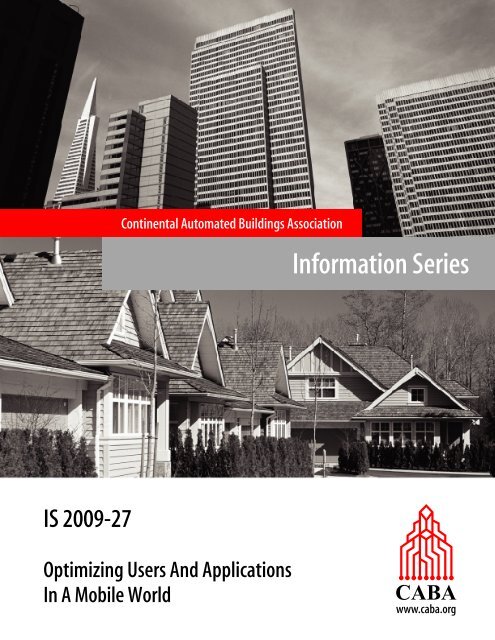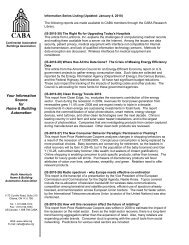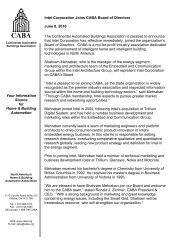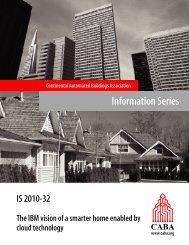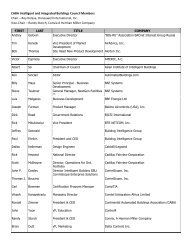Optimizing The Mobile WAN.................................................................11
Optimizing The Mobile WAN.................................................................11
Optimizing The Mobile WAN.................................................................11
You also want an ePaper? Increase the reach of your titles
YUMPU automatically turns print PDFs into web optimized ePapers that Google loves.
Continental Automated Buildings AssociationInformation SeriesIS 2009-27<strong>Optimizing</strong> Users And ApplicationsIn A <strong>Mobile</strong> Worldwww.caba.org
<strong>Optimizing</strong> Users AndApplications In A <strong>Mobile</strong> WorldReprint Date: March 2009This report was developed by Forrester Consulting, and is published by CABA withpermission from Forrester Consulting. CABA expresses its appreciation to ForresterConsulting for making this report available to be included as part of CABA’sINFORMATION SERIES.Neither Forrester Consulting, nor CABA, nor any other person acting on their behalfassumes any liability with respect to: the use of, or for damages resulting from the useof, any information, equipment, product, method or process disclosed in this report.This full report and other INFORMATION SERIES reports appear on CABA’s Web site“Members’ Lounge”: (http://www.caba.org), and are available to CABA Members. Thisinformation is also keyword searchable. Contact the CABA office if you do not have thepasswords to access this material by email caba@caba.org or phone 1-888-798-CABA[2222]. CABA requests that its express written consent be obtained prior to thereproduction, in whole or in part, of any of its INFORMATION SERIES publications.
October 2007<strong>Optimizing</strong> Users And ApplicationsIn A <strong>Mobile</strong> WorldA commissioned study conducted by Forrester Consultingon behalf of Riverbed
<strong>Optimizing</strong> Users And Applications In A <strong>Mobile</strong> WorldTable Of ContentsExecutive Summary ...............................................................................................................................3Research Methodology ..........................................................................................................................3Companies Are More Distributed Than Ever ........................................................................................4And Workforces Are Demanding More <strong>Mobile</strong> Environments .........................................................5IT Struggles To Keep Up As Users Demand Applications That Are Always On, Always Available....7As Apps Go <strong>Mobile</strong>, IT Is Failing To Meet End User Expectations..................................................8Companies Are Already Looking To <strong>The</strong> Network To Solve Woes ...............................................10Overcoming <strong>The</strong> Challenge: <strong>Optimizing</strong> <strong>The</strong> <strong>Mobile</strong> <strong>WAN</strong>................................................................<strong>.11</strong><strong>The</strong> Benefits Of <strong>WAN</strong> Optimization For <strong>Mobile</strong> Users....................................................................12Recommendations For <strong>Mobile</strong> <strong>WAN</strong> Optimization Solutions.........................................................13Buy Now; Plan For Tomorrow.....................................................................................................13Pay Attention To What’s Under <strong>The</strong> Hood .................................................................................13Pick A Vendor With Operational Maturity ...................................................................................13Appendix A: Endnotes..........................................................................................................................14© 2007, Forrester Research, Inc. All rights reserved. Forrester, Forrester Wave, RoleView, Technographics, and TotalEconomic Impact are trademarks of Forrester Research, Inc. All other trademarks are the property of their respectivecompanies. Forrester clients may make one attributed copy or slide of each figure contained herein. Additional reproduction isstrictly prohibited. For additional reproduction rights and usage information, go to www.forrester.com. Information is based onbest available resources. Opinions reflect judgment at the time and are subject to change.- 2 -
<strong>Optimizing</strong> Users And Applications In A <strong>Mobile</strong> WorldExecutive SummaryBased on interviews of more than 300 IT decision-makers in seven countries, Forrester sees theincreasing fragmentation of organizations. <strong>The</strong> problem is threefold:1) Companies are becoming increasingly distributed. We found that companies mustsupport a large number of branch locations, outsourcing relationships, and employees thatare simply no longer in the traditional headquarter location.2) Users are becoming increasingly mobile. On top of more remote locations, users arealso becoming more mobile — relying on broadband wireless technologies to stayconnected and productive.3) Applications are becoming increasingly complex. IT must support all of these locationsand users with a very broad mix of applications. In fact, a large organization can supporthundreds if not thousands of unique apps. But to make matters worse, new applicationtypes like software-as-a-service (SaaS) force IT to recalibrate support mechanisms.<strong>The</strong> result of all this is poor performance and users will no longer tolerate it. Today’s mobile workerexpects access to any application, and when something goes wrong, the help desk gets the call.However, we already know that companies are successfully overcoming this hurdle by deploying<strong>WAN</strong> optimization solutions that are specifically tuned for a mobile environment. <strong>Mobile</strong> <strong>WAN</strong>optimization provides the acceleration needed to ensure consistent performance, room for newapplications, and the ability to ensure end user productivity at all times.Research MethodologyIn September 2007, Forrester Consulting conducted an online survey of 302 IT decision-makersand influencers in North America, Japan, China, France, <strong>The</strong> United Kingdom, Germany, and India.Respondents represented a broad range of industries and included the following breakdown:• Thirty-seven percent of respondents were the seniormost decision-makers in the company;26% were application developers; 24% were network operations and architectureprofessionals; 8% were enterprise architecture professionals; and 6% were storage directoror architecture professionals. (Please note that the sum of percentages in this paper maynot equal 100 due to rounding.)• Fifty-one percent of the respondents were from companies headquartered in the UnitedStates; 8% were headquartered in India; 8% were headquartered in United Kingdom; 8%were headquartered in Germany; 8% were headquartered in France; 8% wereheadquartered in China; and 8% were headquartered in Japan.• Thirteen percent of respondents had 500 to less than 1,000 employees; 30% had 1,000 toless than 5,000 employees; 28% had 5,000 to less than 20,000 employees; and 29% had20,000 employees or more.• Nineteen percent of respondents were from companies with revenues of $50 million to lessthan $200 million; 25% with revenues of $200 million to less than $750 million; 24% withrevenues of $750 million to less than $5 billion; 25% with revenues of greater than $5billion; and 7% did not know their company’s revenue.- 3 -
<strong>Optimizing</strong> Users And Applications In A <strong>Mobile</strong> WorldCompanies Are More Distributed Than EverToday’s IT departments are faced with a dilemma: Users and applications are being pulled furtherapart. On one end you have virtualization and consolidation efforts that are centralizing applicationsand data into fewer locations; on the other, you have users that are becoming increasinglydistributed across work sites. A lot of energy has been spent studying, analyzing, and addressingthe server centralization aspect. We’ve seen an entire industry that has grown up around ITconsolidation using advanced virtualization and management tools. But how many companies areaddressing the fact that people — not technology — are becoming increasingly decentralized? 1 Wethink this is where the majority of friction will occur moving forward. Specifically, Forrester foundthat:• Branch offices are found in all industries and company sizes. Eighty-one percent oforganizations responded that they have branch offices, with more than 30% of companiesindicating they support more than 100 branch offices.• Branches will proliferate as companies further decentralize. And it will get worse: 40%of respondents noted that their organizations would likely be more decentralized threeyears from now. Less than 20% of organizations cited a trend of centralization at theirorganizations, likely due in large part to the increase in the prevalence of technologies toempower the mobile worker (see Figure 1).Figure 1: Enterprises Surveyed Are Increasingly Decentralized Organizations• <strong>The</strong> majority of users are located in these remote locations and branches. In additionto the fragmentation of physical locations within organizations, the data shows that thecompanies surveyed are increasingly mobile. So where are these users? Employeesrequire access to the network from branch offices, home offices, and external work sites.Surprisingly, less than 30% of employees at companies surveyed are located at respondentcompanies’ headquarter locations (see Figure 2).• Noncorporate users grow as outsourcing takes hold. <strong>The</strong> majority of companies wantto take advantage of external workforces through outsourcing. Currently, 26% ofdepartments within companies surveyed are outsourced, with that percentage growing to- 4 -
<strong>Optimizing</strong> Users And Applications In A <strong>Mobile</strong> World33% in three years. Only 20% of respondents cited no outsourcing for today’s businessneeds (see Figure 3).Figure 2: Only 27% Of Employees Reside At HeadquartersFigure 3: Outsourcing Comprises An Increasing Percentage Of Departmental WorkAnd Workforces Are Demanding More <strong>Mobile</strong> Environments<strong>The</strong> trend for companies to become more decentralized is only the tip of the iceberg. Companiesare also becoming more mobile. What started as occasionally working from the road has become arequirement for today’s incoming workforce. Just how mobile have we become?• Fixed broadband still rules connection types, but wireless is quickly gaining. Fixedbroadband is the most common connection type at 72, but we found an astounding 63% ofrespondents note their usage of carrier-based mobile broadband solutions with 55% usingWi-Fi hot spots for connectivity, a trend that Forrester syndicated data also supports (seeFigure 4).• Users are untethering and leaving the desk behind. Thirty-six percent of employeeswithin respondent organizations make use of laptops to work remotely. In general, nearlyhalf — 43% of users — spend some time away from their desks. Laptops are supplantingdesktops, solutions for secure access such as SSL VPN technology are taking hold in both- 5 -
<strong>Optimizing</strong> Users And Applications In A <strong>Mobile</strong> Worldthe enterprises and SMBs, and this means that users are increasingly finding that “work” nolonger is represented by a desk and an office.• Mobility is spreading down to the broader base of the corporate pyramid. <strong>Mobile</strong>users, not the standard road warriors of the past, are a diverse group: 63% occasionallywork from home; 45% are work from home full time; and 28% are contractors or othernoncorporate employees (see Figure 5).Figure 4: Mobility Networks Are Quickly Becoming <strong>The</strong> Preferred Connectivity TypeFigure 5: Road Warriors Aren’t Who <strong>The</strong>y Used To Be- 6 -
<strong>Optimizing</strong> Users And Applications In A <strong>Mobile</strong> WorldIT Struggles To Keep Up As Users DemandApplications That Are Always On, Always Available<strong>The</strong> current rate of change in IT is unprecedented. Companies struggle to balance IT/businessalignment with an ever-growing list of IT projects. But through all this change one aspect remainsconstant: Users still expect access to their applications. In fact, in today’s environment, companiesmust ensure business continuity, which requires that applications are available from any location atany time. For most companies, the challenge is exacerbated by:• A complex mix of applications . . . <strong>The</strong> current mix of applications, which combinessoftware-as-a-service (SaaS), homegrown, and packaged applications, will remainrelatively static over the next three years. But it’s still a daunting list with no one categorydominating. We found packaged applications consumed only a third of the applicationportfolio and homegrown apps only another quarter. On the rise are more network-centricoptions like SaaS-based applications, which challenge traditional governance andbudgeting processes (see Figure 6).• . . . deployed to meet business requirements. We asked respondents what was driving achange in the application mix. To no surprise, we found cost and upgrades still reignsupreme, but business alignment is right behind. We are beginning to see IT budgets showa little life, and IT is quick to capitalize on the new funds to support new, innovativebusiness projects. Rounding out the top five drivers were user productivity, businessprocess improvement, and customer satisfaction. (see Figure 7).Figure 6: Large Enterprise Packaged Apps Make Up <strong>The</strong> Largest Part Of <strong>The</strong> Application Mix- 7 -
<strong>Optimizing</strong> Users And Applications In A <strong>Mobile</strong> WorldFigure 7: Business Requirements Trail Right Behind Cost And UpgradesAs Apps Go <strong>Mobile</strong>, IT Is Failing To Meet End User ExpectationsWhat happens when you mix decentralization, mobilized workforces, and a complex applicationmix? A busy help desk. According to survey respondents, complaints from IT constituents are notuncommon. In fact, 86% of organizations indicated that they receive end user complaints. And themost common complaint, far and away, is application performance. In fact, laptop hardware or OSissues came in as a distant No. 2 (see Figure 8).Traditional application woes will not diminish, either. As enterprises increase the number andcomplexity of applications that are deployed to mobile users, the potential for applicationperformance issues grows. <strong>The</strong> increasing mobility of commodity data — email, contacts, andcalendaring — gives way to more role-specific and task-essential applications such as field serviceapplications and sales force automation applications (see Figure 9). <strong>The</strong>se applications, while moreessential to workers when mobile, also demand greater bandwidth and a network that can handlemultiple users pulling from one or a small number of data stores across multiple networks.- 8 -
<strong>Optimizing</strong> Users And Applications In A <strong>Mobile</strong> WorldFigure 8: <strong>The</strong> Vast Majority Of Companies Incur Complaints From Remote UsersFigure 9: Mobility Is Trending Toward Role- And Task-Specific Applications- 9 -
<strong>Optimizing</strong> Users And Applications In A <strong>Mobile</strong> WorldCompanies Are Already Looking To <strong>The</strong> Network To Solve Woes<strong>The</strong> networks that enterprises use are moving beyond the role of dumb transport played in the past.Security and acceleration technologies are key initiatives for organizations that must deployapplications to a mobile, laptop-carrying workforce. In fact, we found that:• VPN technology is the most prevalent technology for users accessing applications.SSL VPNs are a critical underpinning for applications in a mobile world. Respondentsagreed, and 35% are currently underway with a large-scale, strategic deployment of SSLVPN technology. Not far behind are niche mobile VPN technologies, with 30% ofenterprises citing a large-scale, strategic initiative underway (see Figure 10).• <strong>WAN</strong> optimization is the second most common technology to overcome woes. Inaddition to ensuring secure access to network resources, enterprises surveyed are lookingto <strong>WAN</strong> optimization — sometimes referred to as wide-area data services or <strong>WAN</strong>acceleration — to improve the performance and end user experience. Forty-eight percentof enterprises surveyed noted a current implementation of the technology, with 26%considering the existing implementation as already large-scale and strategic.• Emerging virtualization technologies are in nascent stages. Moving beyond thenetwork, we see that organizations are looking to client management and virtualizationtechnologies to help alleviate the application deployment woes; however, we expect thatthese technologies will take hold in 2008 as they mature. Moreover, we expect thesebandwidth hungry technologies to further drive the need for VPN and <strong>WAN</strong> optimization.Figure 10: Access Technologies, Network Optimization Top IT’s Investment List- 10 -
<strong>Optimizing</strong> Users And Applications In A <strong>Mobile</strong> WorldOvercoming <strong>The</strong> Challenge: <strong>Optimizing</strong> <strong>The</strong> <strong>Mobile</strong><strong>WAN</strong>We already know that companies are looking to the network to help overcome application woes. Butwe believe that one technology stands out as providing the most potential for solving the mobilebottleneck: <strong>WAN</strong> optimization. We know that this is a fairly well understood technology, but we alsowanted to see just how strategic this was for today’s organizations. We were shocked to find thatmore than 40% of respondents believe that <strong>WAN</strong> optimization is absolutely a strategic componentto today’s distributed and mobile environments (see Figure 11). This technology is seen as criticalto the success of distributed organization, despite that fact that it is not yet a well-adoptedtechnology. Why is this?Figure 11: Companies See <strong>WAN</strong> Optimization/WDS As Important Infrastructure<strong>WAN</strong> optimization, at its simplest level, is a technology designed to improve applicationperformance by increasing throughput and decreasing latency. It's a symmetrical technology,meaning that hardware or software on both ends of the link help achieve end-to-end optimization.<strong>WAN</strong> optimization applies four common optimization techniques: 1) caching; 2) protocoloptimization; 3) compression; and 4) traffic management. Caching keeps local data at your remotesites, which tackles both throughput and latency by avoiding unnecessary trips across the <strong>WAN</strong>. 2Protocol optimization aims to reduce latency by removing inefficiencies in key protocols like MAPI,CIFS, and TCP. 3 Compression increases throughput by removing redundant patterns. 4 And finally,traffic management uses quality of service (QoS) mechanisms to shape bandwidth and prioritizeyour most critical apps (see Figure 12). 5 - 11 -
<strong>Optimizing</strong> Users And Applications In A <strong>Mobile</strong> WorldFigure 12: <strong>WAN</strong> Optimization Accelerates Apps And Data To Branches And <strong>Mobile</strong> Users<strong>The</strong> Benefits Of <strong>WAN</strong> Optimization For <strong>Mobile</strong> UsersAs enterprises continue their march toward mobility and an increasingly distributed organization, theimportance of accelerating access to network assets and applications proves increasingly critical.<strong>WAN</strong> optimization solutions aid users connecting to the network and accessing information,regardless of the access network from which they originate. In addition to simply empowering themobility transition in the organization, <strong>WAN</strong> optimization solutions can guarantee a continuity ofexperience inside and outside the organization. Specifically, mobile <strong>WAN</strong> optimization helps tacklethe top issues plaguing IT (see Figure 13):• Consistent performance for all applications. More than 30% of respondents claimedthat performance was very important across extranets and intranets. <strong>WAN</strong> optimization notonly improves end-to-end application performance, but it also irons out performancewrinkles — providing a consistent end user experience regardless of location. <strong>Mobile</strong> <strong>WAN</strong>optimization can also provide a cost-effective way of accelerating apps where a softwareagent is more feasible than a hardware appliance on the remote end.• Room for deploying new business applications. For many companies, the mobile <strong>WAN</strong>is simply too latent or too congested to support innovative new line-of-business apps.However, <strong>WAN</strong> optimization provides the means for decreasing overall <strong>WAN</strong> utilization andfreeing up considerable bandwidth. <strong>The</strong> result? IT can take confidence in changing theapplication portfolio and add apps that drive user productivity, business processimprovement, and customer satisfaction.• Improved availability and disaster preparedness. <strong>WAN</strong> optimization solutions are alsocritical in providing the data acceleration needed for backup and replication software. We’vealready seen companies achieve tenfold improvement in backup software running acrossthe <strong>WAN</strong> to branch offices. But with the addition of a mobile <strong>WAN</strong> optimization agent, thissame benefit can be extrapolated to any remote user. This ensures workforce continuity- 12 -
<strong>Optimizing</strong> Users And Applications In A <strong>Mobile</strong> Worldand decreases end user downtime while they’re brought back to a productive state, shouldsomething go awry.Figure 13: <strong>WAN</strong> Optimization Solves <strong>The</strong> Top Issues Effecting Apps On <strong>The</strong> <strong>Mobile</strong> <strong>WAN</strong>Recommendations For <strong>Mobile</strong> <strong>WAN</strong> Optimization SolutionsChoosing the right mobile <strong>WAN</strong> optimization solution requires understanding a few key criteria.Buy Now; Plan For TomorrowTaking on a <strong>WAN</strong> optimization solution should take into account more than simply the application orapplications that the solution may initially be adopted to accelerate. <strong>WAN</strong> optimization, whenproperly applied, will work to improve the experience of users on the network, ensuring peakperformance from any location, on any access network, as well as the performance of specificapplications those users are attempting to access.Understand and have a plan for how the technology will scale. Be sure to select a <strong>WAN</strong>optimization solution that both scales up and scales out. Scale-up means technology that supportsmore applications over time and an increasing amount of data. <strong>The</strong> tricky one is scale-out, though,which means supporting an increasing swath of users, not simply the “road warriors” that make up asmall percentage of users in most organizations. This means selecting a vendor that understandsthe software agent and has thought through how that agent can be easily deployed and supportedon a large number of remote laptops and desktops. It also means selecting a vendor thatunderstands both branch offices and mobile workforces so that you can scale out with your usersand provide a consistent experience across all remote activity.Pay Attention To What’s Under <strong>The</strong> HoodEvaluating solutions for <strong>WAN</strong> optimization should take into account more than the optimization ofnetwork traffic. Evaluate a solution with respect to the underlying appliance architecture. Pick avendor that supports clustering and redundancy to ensure maximum reliability. <strong>WAN</strong> optimizationwill become a critical part of your mobile architecture, and potential failure may cause your trafficload to extend beyond your network’s capacity. Also, pick an appliance that fits into existing securityarchitectures to ensure that SSL-encrypted traffic can still be accelerated for your mobile apps.Pick A Vendor With Operational MaturityNo two <strong>WAN</strong>s are alike. Working with a vendor that has experience in solving the specific issues ofyour organization will ensure that late-term support and performance issues do not arise. This iseven more true with mobile <strong>WAN</strong>s. Make sure the vendor has plenty of references in your industrythat can attest to support. Otherwise, you may get stuck with a networking vendor that doesn’t trulyunderstand how to support a software agent or specific acceleration tricks that need to be applied tothe nuances of a mobile environment.- 13 -
<strong>Optimizing</strong> Users And Applications In A <strong>Mobile</strong> WorldAppendix A: Endnotes1 For the remainder of this paper, we will use “decentralization” to refer to the distribution ofemployees and the move toward an increasingly mobile workforce.2 Caching has come a long way in the past 10 years. <strong>The</strong>re's object caching, which stores an entireobject like a GIF graphic or PowerPoint file on disk, and byte caching, which looks for repeatingpatterns, stores those to disk, and then only sends small deltas to those patterns as the data getsupdated. Object and byte caching combine to offer the biggest impact on improving Web-basedapplications, email, and file services.3 Not all protocols can be optimized, but many of the "chatty" ones can be. Here's how it works.<strong>WAN</strong> optimization removes the unnecessary roundtrips that many protocols — which were neverdesigned to run in a <strong>WAN</strong> environment — introduce as part of their set-up process. For example,take Common Internet File System (CIFS), which is a common protocol used for Microsoft filesharing. If you were to open up a file located in a central file server, then it would not be uncommonfor CIFS to use 25 roundtrips of overhead before data is even transferred. If your <strong>WAN</strong> had 80 msof latency, then you'd pay a "penalty" of 2,000 ms (2 seconds) in just overhead! Protocoloptimization reduces these roundtrips to the minimum 160 ms by parallelizing the protocolhandshakes. Protocol optimization is best-suited to Web traffic (TCP and HTTP), email (MAPI), andfile sharing (CIFS for Windows, NFS for Unix and Linux).4 Compression has been around for more than a decade, with the most common approach beingthe standard GZIP algorithm. Compression reduces bandwidth consumption but is not suitable forreal-time traffic or precompressed data, like graphics files.5 Traffic management has also been around for nearly a decade. It's not an accelerationtechnology, but it does help by using common Differentiated Services Code Points (DSCP) and IPType of Service (IPTOS) as mechanisms that prioritize your application data. Furthermore, most<strong>WAN</strong> optimization solutions can rate-shape traffic. For example, you could determine that voicegets 40% of your link capacity; mission-critical apps get 40%; and everything else gets theremaining 20%.- 14 -


